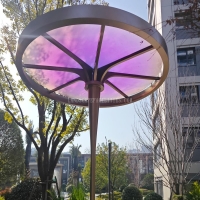Welcome to the website for landscape facilities products and knowledge.
What are the key considerations for ensuring the Landscape Round Table meets the needs of hybrid work models?
The modern workplace has undergone a fundamental shift, with hybrid work models becoming the standard rather than the exception. In this new paradigm, the physical office must justify its existence by fostering connection and collaboration that is difficult to replicate remotely. The Landscape Round Table, a versatile and inclusive piece of furniture, is uniquely positioned to serve as a hub for this activity. However, simply placing one in a room is not enough. To truly meet the needs of a hybrid workforce, several key considerations must be addressed.
First and foremost is technological parity. A Landscape Round Table designed for hybrid work must be more than a surface; it must be a technological nucleus. This involves integrating high-quality, 360-degree cameras and microphones that can capture every participant seated around it with equal clarity. The audio-visual system must eliminate the distinction between the person in the seat and the colleague on the screen, creating a seamless experience where remote participants are not mere observers but active contributors. This requires investment in reliable, user-friendly video conferencing software and hardware that minimizes technical friction.
Beyond hardware, the design and facilitation of the meeting itself are critical. The round shape naturally promotes equality and inclusion, but the meeting leader must be intentional about leveraging this. This means establishing clear protocols for turn-taking that explicitly include remote participants. Techniques such as pausing for virtual input, using collaborative digital whiteboards visible to all, and designating a facilitator to monitor the virtual "room" are essential. The goal is to create a meeting culture where a raised hand on screen carries the same weight as a raised hand in the physical space.
Furthermore, the table's environment must support flexible and dynamic interaction. The surrounding space should be adaptable, allowing for quick reconfiguration for different group sizes and activities. Lighting must be optimized for video calls, avoiding harsh shadows or backlighting that can make in-person participants difficult to see. Acoustics are equally important; sound-absorbing materials should be used to prevent echo and ensure crystal-clear audio for those dialing in. The physical comfort of in-person attendees also matters, as an uncomfortable team member is a disengaged one.
Finally, the principle of flexibility extends to the furniture itself. The ideal Landscape Round Table for a hybrid model might be modular, allowing it to be broken down into smaller units for team huddles or reconfigured for a larger all-hands meeting. This adaptability ensures that the investment continues to deliver value as team needs and work patterns evolve. By thoughtfully integrating technology, inclusive practices, and flexible design, the Landscape Round Table can transcend its physical form to become the heart of a truly connected and productive hybrid workplace.
Related search:

Recommendation
Metal frame with gradient color acrylic combined with high-end shading landscape facilities